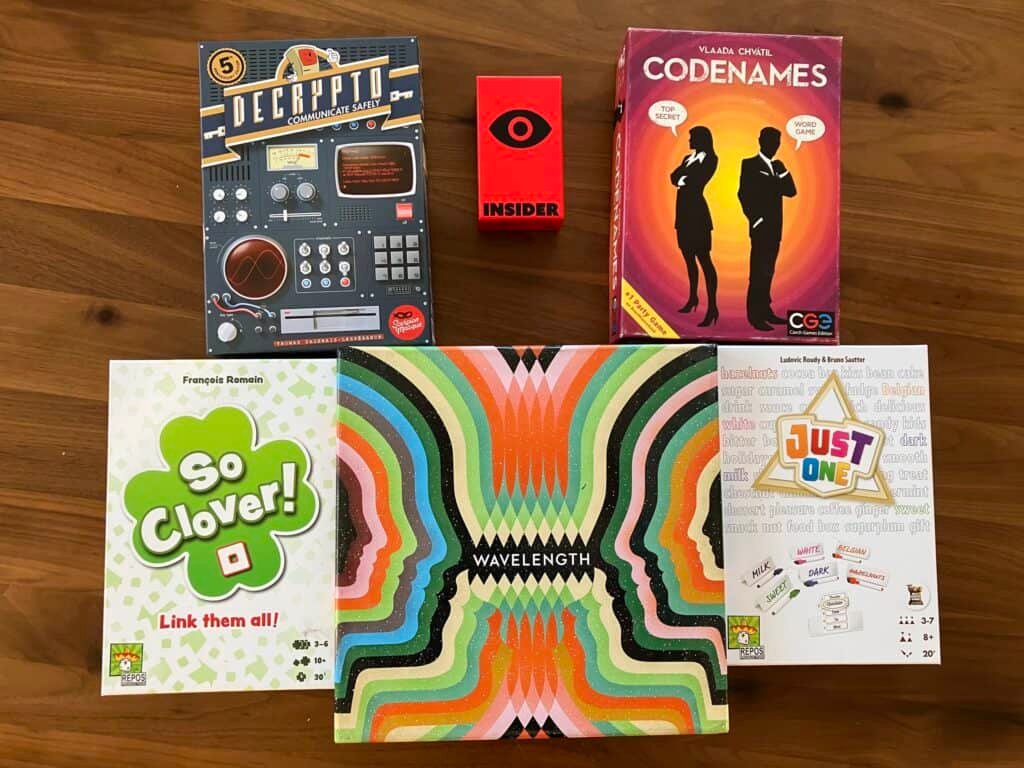
Are you ready to take your gathering to the next level? The right party game can be the key to an unforgettable experience. But beware, because the wrong party game can lead to mass confusion, conflict, or worst of all, a dull and uneventful time. In this blog post, we will explore the 8 best party games, discovering the ones that are sure to bring laughter, excitement, and lasting memories to any occasion. So, let’s dive in and find out which party games are the life of the party!
What is a Party Game?
A party game, in its essence, is a social and interactive game that is primarily designed to be played with a group of people in a casual, fun setting. It’s a broad term that encapsulates a wide range of games, but, here at The Board Game Collection we believe the best party games share a few key attributes.
1. Simple and Approachable:
The rules are simple and approachable, allowing everyone to dive right in without feeling overwhelmed.
A good rule of thumb: if you can’t learn how to play just by reading the back of the box, you might be holding a game that’s too complex.
2. Flexible and Accessible:
The game can also be joined or left easily – you know, in case there’s a turkey in the oven that needs tending or someone happens to arrive 30 minutes late.
For this reason, we prefer games with short rounds and team or co-op dynamics, so that one player doesn’t have to be constantly present. It’s easy to play a few times, switch teams, and everyone gets a chance to be on the winning team.
3. Playful Atmosphere and Low Stakes:
The game minimizes direct conflict, creating a playful atmosphere with low stakes.
We don’t want to provoke political debates or introduce a slew of “take that” mechanics.
Winning and losing shouldn’t be the sole focus of these types of games.
4. Player Empowerment and Enjoyment:
The spotlight is on the players themselves, allowing them to feel clever and humorous.
We aren’t a fan of games that take away all the potential creativity of the players by trying too hard to be raunchy or clever.
5. Unforgettable Moments and Enduring Impact:
Players have the opportunity to exhibit their individuality and ingenuity, leading to moments that leave a lasting impression even after the game concludes.
While all games strive for this, party games distill it to its very core. This is what they do best.
8 Best Party Games
Decrypto
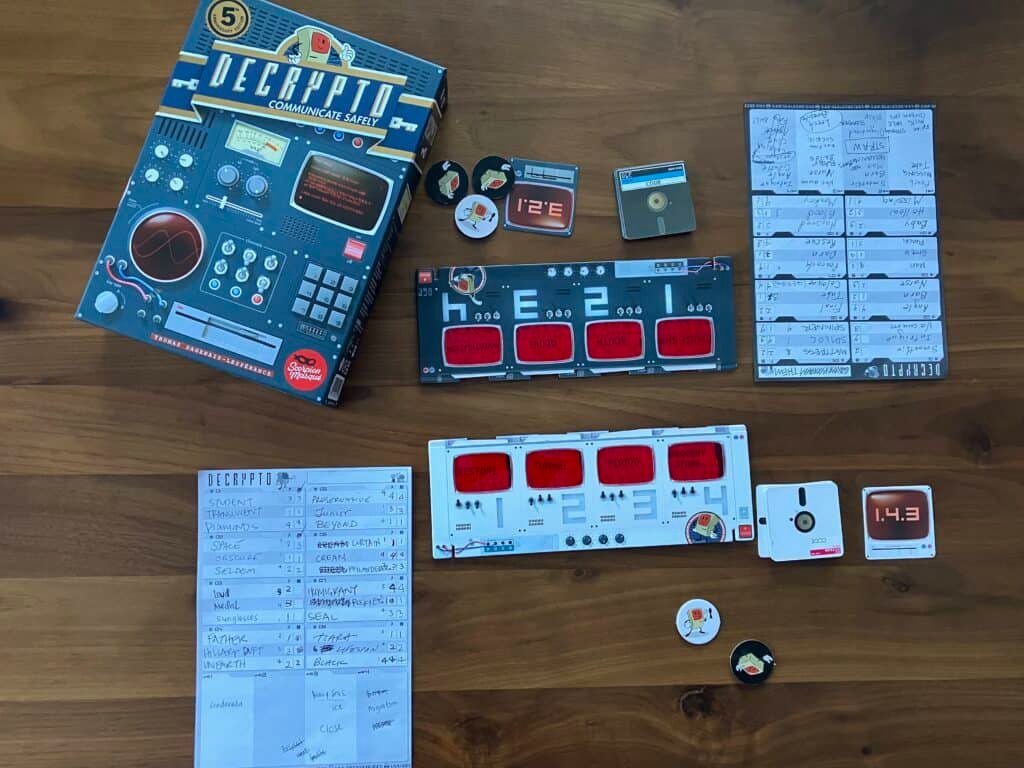
Players: 3 to 8
Duration: 15 to 45 minutes
How to Play
Decrypto is a team-based game where two teams try to correctly interpret secret codes. To start, each team has a screen with four words, each associated with a number from one to four. In each round, one player from the team – the ‘encryptor,’ – gets a series of numbers that relates to the words on the screen. They are trying to get their teammates to guess the words associated with the numbers in the correct order. For example, if the words are ‘Moon,’ ‘Banana,’ ‘Glass,’ and ‘Warrior,’ and the encryptor gets a card that says “2-3-1-4”, they will need to hint at “Banana”, “Glass”, “Moon”, and “Warrior”. The encryptor might say “Yellow, Clear, Apollo, Fierce” to try to get their team to guess correctly.
The rest of the team then tries to guess the correct numbers. But there’s a catch: the opposing team gets to listen to this clue and guess the numbers too! The teams keep track of each other’s clues and attempt to crack the code. If the opposing team guesses the code correctly twice, they win the game. But if a team gives a clue that their own team cannot guess correctly, they receive a black mark of failure – get two of these, and they lose the game. Decrypto is a game of strategic communication where every word (and number) counts!
Why Decrypto is a great party game
Decrypto has earned its spot as the number 1 party game on Board Game Geek for several reasons. Despite breaking a few rules, it has created some of the best social gaming experiences I’ve ever had. While the rules may take a second to learn, this game requires a lot more active engagement than some of the lighter options on our list.
However, Decrypto pushes you to really know your teammates as you try to outwit your opponents. It’s the most engaging game on our list, providing the perfect platform for being clever and/or sneaky. It is definitely more challenging and demanding than others, making it ideal for gatherings of clever people who already know each other well. However, it may not be the best choice for those who rarely play games or might be in and out.
Decrypto offers a unique gameplay experience that sets it apart from other party games. It involves interpreting wavelengths and aligning with teammates’ thoughts, which adds strategic depth and surprising twists to the game. The need for active engagement and cleverness makes it a captivating and intellectually stimulating experience. Decrypto not only challenges your mental abilities, but it also serves as a catalyst for forming new friendships and stimulating friendly rivalry. The combination of its unique mechanics and social dynamics make it a standout choice for those looking for a memorable and engaging party game.
Decrypto‘s ability to create unforgettable social gaming experiences, the requirement for active engagement, and the opportunity to showcase cleverness and sneakiness make it a standout choice. While it may be more challenging and demanding than other options, it rewards players with a deeply engaging and intellectually stimulating gameplay. If you’re gathering with a group of clever individuals who already know each other well, Decrypto is the game to choose for an immersive and memorable gaming experience.
So Clover – Unleash Creativity and Laughter
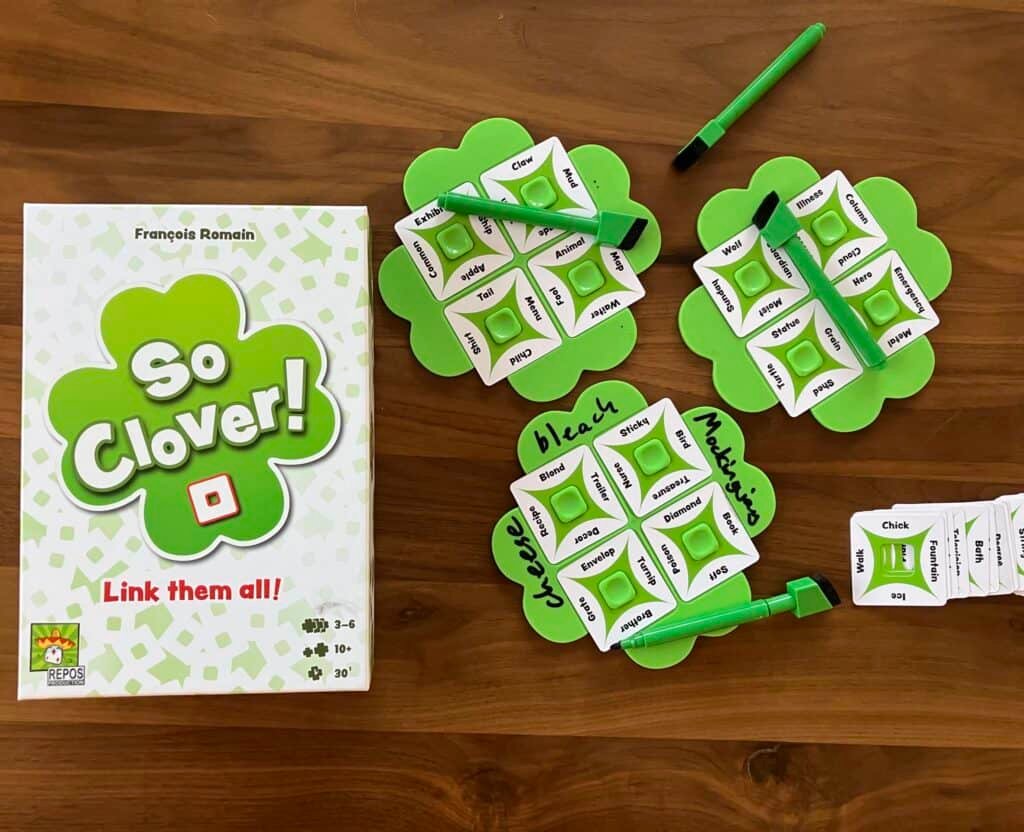
Players: 3-7
Duration: 20 to 30 minutes
How to Play So Clover
So Clover is an exciting cooperative word-association game where players work together to score the highest points. The game begins with each player being given a clover-shaped board with four words written on it. The goal is to come up with a single clue that links each pair of adjacent words on the board. Each player then writes down their clues without revealing the words they are associated with.
The first person puts their board in the middle of the table, and all other players attempt to correctly match each clue to the words on the board. The game continues with the next person until the last person has presented their clover, and the team’s score is based on the number of correct matches. The challenge lies in creating clever clues that can accurately and uniquely relate the words, fostering a game that is as challenging as it is entertaining.
Why So Clover is a great party game
So Clover is a party game that strikes a fine balance between strategic engagement and accessibility, making it an ideal choice for groups of varying experience levels. The game mechanics are quite straightforward and easy to understand, allowing for quick setup and teaching. Nevertheless, the need to cleverly connect two words introduces a dash of strategic thinking that elevates the gameplay beyond simple guesswork. Despite the occasional frustration players might face when dealing with challenging word combinations, the game maintains an enjoyable atmosphere as it is devoid of direct conflict and promotes a sense of team camaraderie.
Unlike certain other games such as Codenames, which push the envelope of strategic clue giving, So Clover limits the challenge to linking only two words at a time. The words are randomly assigned, which adds a layer of unpredictability and fun to the gameplay, especially when you get stuck with a particularly obtuse pairing. This rule strikes the perfect balance of cleverness required, ensuring that the game remains engaging without overwhelming the players. We think it does a particularly good job of evening out the playing field, making it enjoyable for everyone around the table, regardless of their gaming proficiency.
Another notable feature of So Clover is its inclusivity. The game doesn’t necessitate a deep understanding of other players, making it an ideal choice for groups where people may not know each other well. This makes it less intimidating compared to games like Decrypto or Codenames, which heavily rely on players’ understanding of each other’s thought processes. So, if you’re seeking a game that is easy to teach, moderately strategic, and doesn’t require intimate knowledge of fellow players, So Clover could be the right pick for your next game night.
Just One – Wordplay Wonders
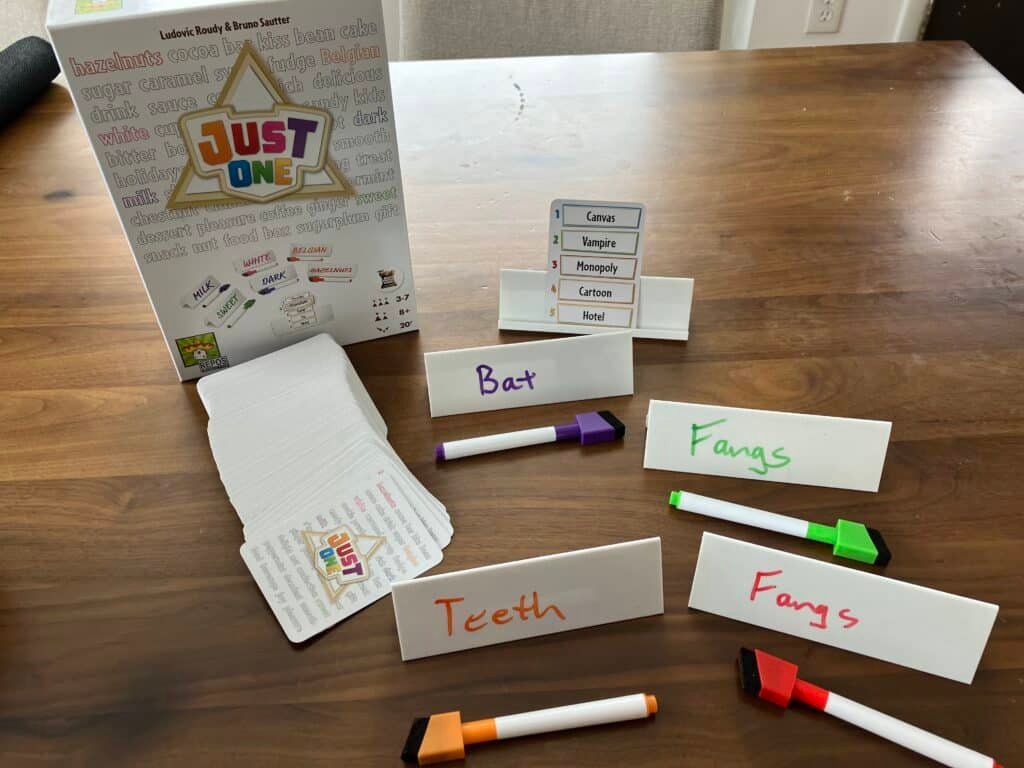
Players: 3 to 7+
Duration: 20 minutes
How to Play Just One
Just One is a cooperative party game where players work together to discover as many mystery words as possible. The game begins with one player being the ‘guesser’ while the rest of the players see the mystery word. Each player, except the guesser, writes a one-word clue on their easel to help the guesser determine the mystery word.
Here’s the twist: if any players write the same clue, those clues are cancelled out before the guesser gets to see them. So only words that are unique can be shown to the guesser. This encourages creativity and strategic thinking while minimizing the chances for easy or common clues. The goal is to collaboratively unearth the maximum number of mystery words, making every round a combined effort of cleverness and teamwork.
Why Just One is a Great Party Game
Just One is incredibly easy to play, making it accessible to players of all experience levels. While it requires a bit of cleverness, it doesn’t demand excessive mental energy, allowing everyone to participate without feeling overwhelmed. The game creates memorable moments when players’ clues unexpectedly overlap, leading to laughter-inducing misunderstandings.
One of the highlights of Just One is the way it encourages creativity and unpredictability. Whether players’ clues perfectly align or take a hilarious detour, these moments of matching or inventive clue-giving are truly enjoyable. It’s always a delight when all the helpful clues cancel out, leaving the guesser with a unique combination of offbeat clues. This game excels at creating these fantastic moments.
If you’re searching for a game that is incredibly easy to teach and play right away, Just One is the perfect choice for any group, whether your friends or family members are avid gamers or not. It may not hold the interest of serious gamers for an extended period, but that’s not the purpose of this game. Just One is all about bringing people together, fostering laughter, and creating unforgettable moments for everyone involved.
Wavelength – Mind-Bending Revelry
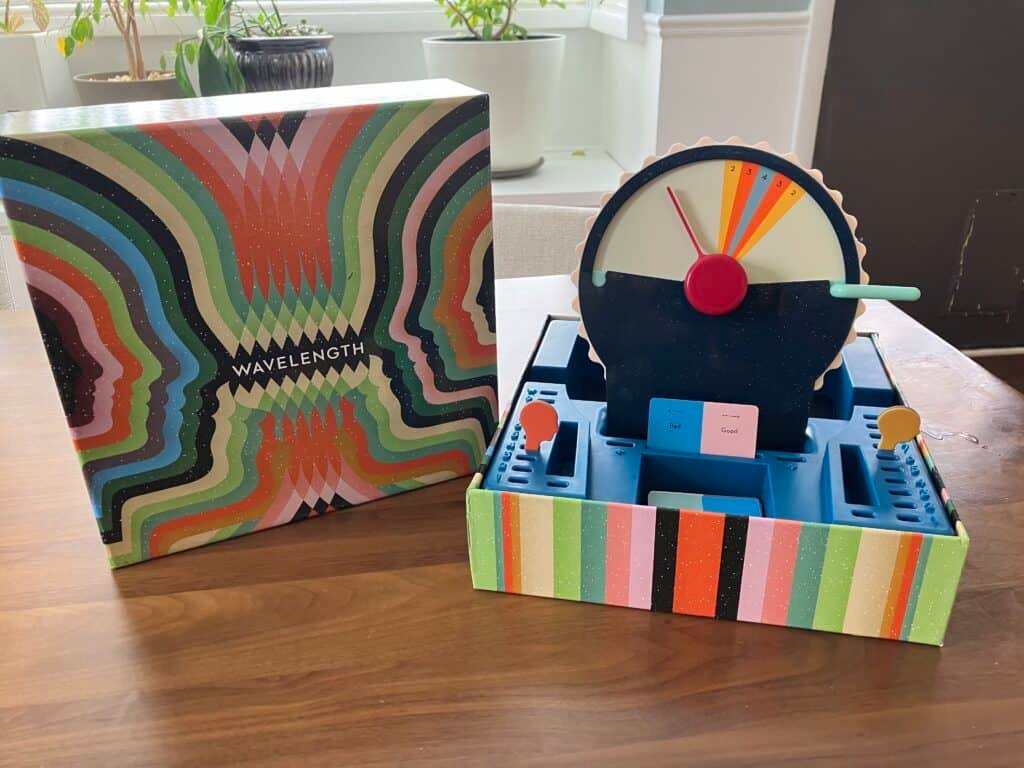
Players: 4+ (best at 6 or 8, but you can play with many more, especially if people are filtering in and out)
Duration: 30 min
How to Play Wavelength:
Wavelength is a social guessing game where two teams compete to read each other’s minds. The gameplay involves a rotating clue-giver on each team who adjusts a dial hidden behind a screen to match a randomly determined spectrum. This spectrum could range from ‘hot to cold’, ‘large to small’, etcetera, and the clue-giver must give a hint that leads their team to guess where the dial is on that spectrum.
For example, if the dial is set close to ‘hot’ and the spectrum is ‘hot to cold’, the clue might be ‘lava.’ The team then discusses where they think the dial is and turns the screen to reveal if they are correct. Points are scored based on how close to the target the team guesses, and one of the great features here that keeps everyone engaged the whole time is that the other team can steal one point if they can guess whether the answer is hotter or colder than the guess. Play then passes to the next player and the first team to ten points wins.
Why Wavelength is a Great Party Game:
Wavelength is more than just a game; at its core, it serves as a conversation engine that fuels discussions, debates, and a deeper understanding of your friends. It’s built around the concept of guessing where your teammate will place a hidden target on a spectrum that ranges from one extreme to the other, such as ‘rough to smooth’ or ‘light to heavy’. This seemingly simple premise opens up a world of communication, transforming each turn into an exciting exploration of your teammates’ thought processes, preferences, and individual perspectives.
One of the most engrossing aspects of Wavelength is how it generates heated arguments about the the most mundane things. As players attempt to pinpoint the exact location of the spectrum that their teammate had in mind, debates naturally arise. Players negotiate the finer points of the spectrum and advocate for their interpretation, all in a spirited attempt to understand their teammate and score points. This argumentation, however, never devolves into conflict. Instead, it stimulates dialogue and fosters collaborative problem-solving, making each game an unforgettable experience.
Wavelength also provides a unique opportunity to get to know your friends on a different level. As individuals reveal their reasoning and reactions, you gain insights into their thought processes and perspectives that day-to-day interactions might not unveil. For instance, how a friend perceives the scale from ‘funny to serious’ can open a window into their sense of humor, personal values, and life experiences. This enriching aspect of Wavelength makes it more than a party game; it’s an enjoyable and insightful journey into the minds of your friends.
Codenames – Uncover the Secret Agents
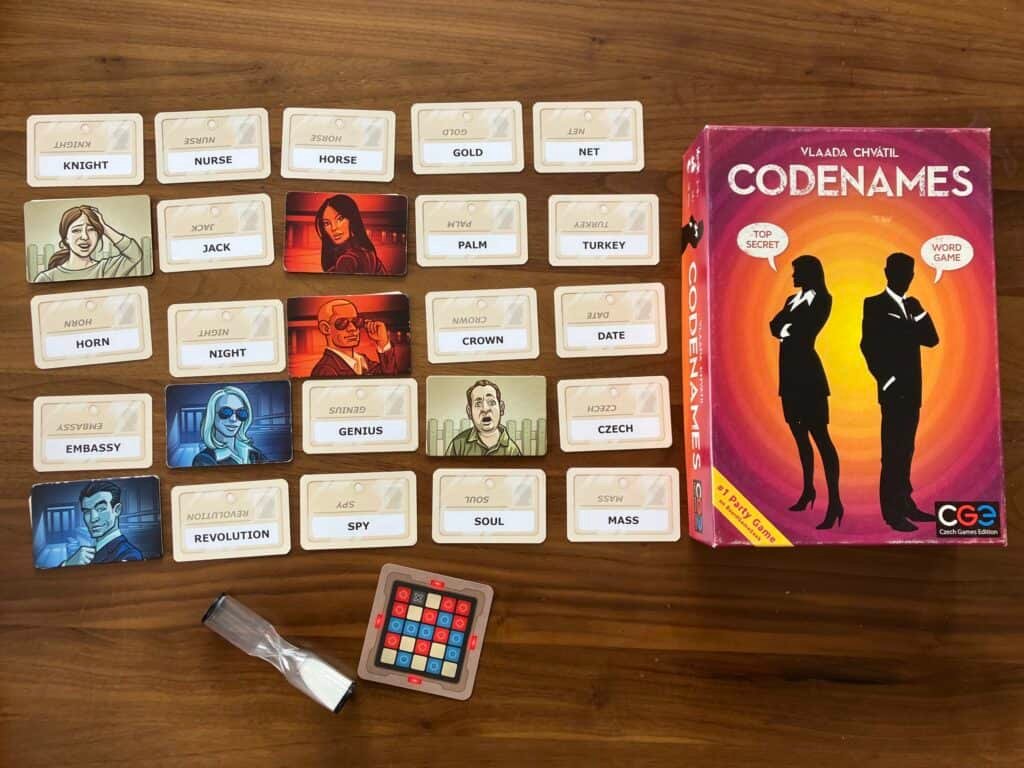
Players: 2 to 8+
Duration: 15 minutes
How to Play Codenames
Codenames is a popular word-based party game that involves two teams competing to contact all of their agents first using only single-word clues. The game is led by two spymasters, one person from each team, who know the secret identities of all 25 agents. Their teammates are tasked with guessing the names of these agents. The spymasters provide one-word clues that can point to multiple words on the board, while their team attempts to guess the words of the right color, avoiding those that belong to the opposing team and the assassin, which would end the game immediately. The challenge lies in giving clues that are as inclusive as possible without leading your team to guess a word of the wrong color, or worse, the assassin.
Why Codenames is a great party game
Codenames is a brilliant party game for those who appreciate intellectual stimulation and enjoy feeling clever. The beauty of this game lies in its ability to create an environment where players can exhibit their skills in associating clues with multiple words. It’s a game that truly rewards creativity and quick-thinking. However, it’s worth noting that the skill gap can sometimes be wide – there are individuals who are naturally adept at this game. Therefore, it’s beneficial to put some thought into the formation of teams, striving to balance the experience levels across them. This can ensure that the game remains competitive and enjoyable for everyone involved.
The game also thrives on the familiarity and synergy between team members. The more you understand your teammates’ thought patterns, the better you can predict the leaps of logic they might make to connect clues, making the game more exciting and engaging. However, this attribute may also be seen as a weakness in certain scenarios, especially when playing with individuals you don’t know well.
Furthermore, Codenames tends to be a quieter game and can experience moments of downtime as players ponder their clues. This might not be the best fit for groups who prefer constant action and immediacy.
Despite these potential drawbacks, Codenames often manages to keep the atmosphere at the table light. During quieter moments, players usually take the opportunity to socialize, keeping the overall vibe lively and enjoyable. Although it has more strategic depth than So Clover, it’s still not as complex as Decrypto, striking a balance that caters to a wide range of players. Its ability to accommodate non-gamers, teenagers, and even older kids without much difficulty makes it an inclusive and versatile choice for any gathering.
Insider – Unmask the Deceiver
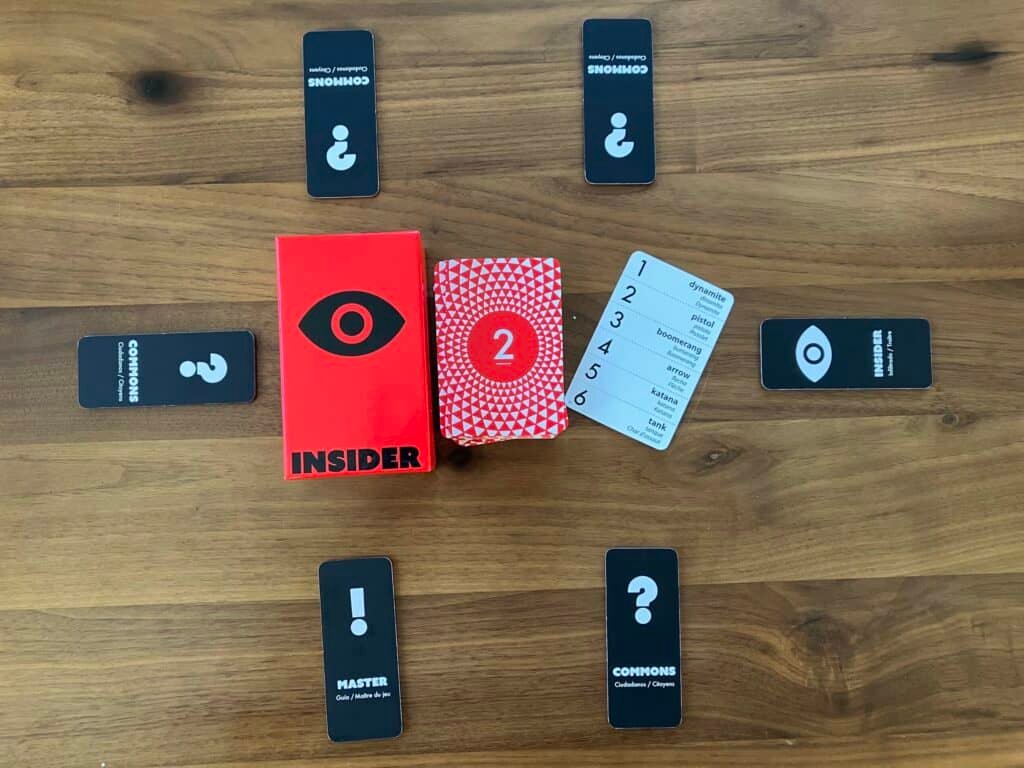
Players: 4 to 8
Duration: 15 minutes
How to Play Insider
Insider is a fast-paced word game where players work together to solve a mystery word, all while trying to identify the “Insider” who already knows the word, but is hiding their identity. The game begins with the first person selecting a word card and secretly showing that card to one person, who was assigned as the insider. It’s then a game of yes/no questions and all players, including the Insider, try to guess the word. The Insider needs to help the team guess the correct answer, but without making it too obvious that they knew the word all along.
Once the mystery word has been guessed, the game shifts as players try to identify who among them is the Insider through a vote. If they guess and are correct, the non-Insider players win. However, if they are incorrect, or if they take too long to guess the word, the Insider person wins. This game combines elements of deduction, deception, and quick-thinking, offering an exciting challenge for all players.
Why Insider is a Thrilling Party Game
Insider is a captivating social deduction game that delivers an exhilarating dose of thrill and suspense. Players come together to unravel a secret word, but there’s a catch – one player, known as the Insider, subtly manipulates the group. With each round filled with limited time and mounting suspense, the game injects an element of intrigue and surprise, keeping everyone on their toes and fully engaged.
When I played Insider, it immediately became my go-to social deduction game. It perfectly captures the essence of the genre without any unnecessary frills. Gone are the complexities of player illumination and deception found in other games like Werewolf. Instead, Insider offers a refreshing simplicity where one person must be helpful, but not too helpful. It’s a game that provides immediate gratification, as you swiftly move on to the next round, without the need to slog through six rounds of gameplay.
What sets Insider apart is its accessibility. At its core, it’s just like playing a game of 20 questions. Everyone already knows how to play, making it easy to dive right in. All you need to do is explain the roles and the voting process, and you’re ready to go. Insider is a fantastic choice to bring out at any gathering, allowing you to play as many rounds as people are interested in. It’s a game that brings excitement, strategy, and endless fun to the table.
Kites: Time to Fly
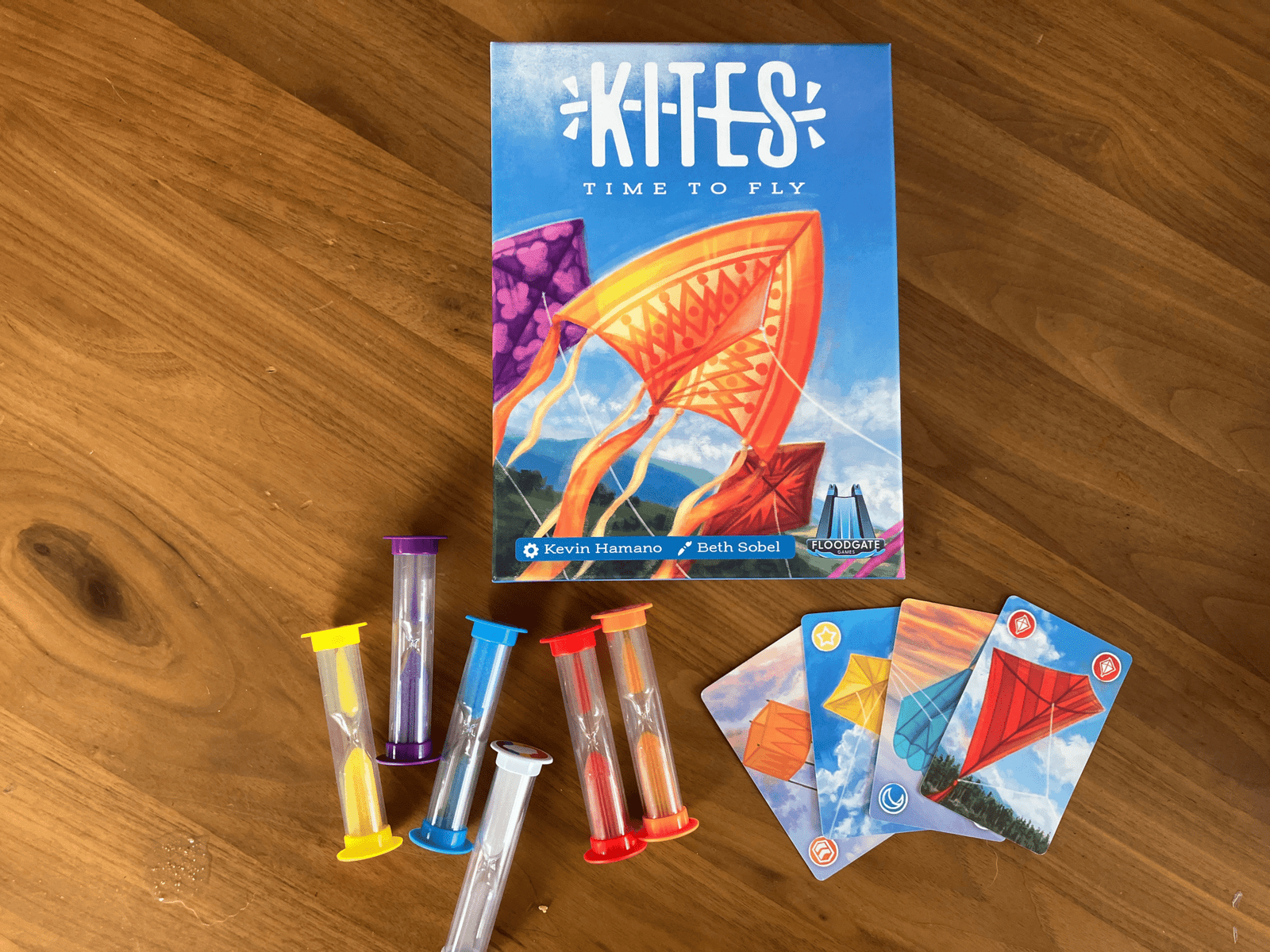
Players: 2 to 6
Duration: 20 minutes
How to Play Kites: Time to Fly
Kites: Time to Fly is a real-time cooperative board game that has players frantically playing cards and flipping timers to keep their flight up in the air. To set up the game, place the seven sand timers in the center of the table on their sides and deal out the cards. The first timer is flipped, starting the game. Players then take turns playing cards and, when a card is played there are symbols that correspond to one or two of the sand timers in the center of the board, which have to be flipped when they are played.
You’ll need to work together to strategically play cards because if even one timer runs out, you lose. But if the last person manages to play their last card, everyone wins. It’ll take teamwork and planning, and maybe even a couple tries, to get it right, but it’s a surefire way to get everyone working together toward a common goal and build camaraderie.
Why Kites: Time to Fly is a great party game
Kites: Time to Fly is one that party guests will love because it manages to bring a lot of tension, but still feel lighthearted and fun. That’s important with cooperative games, because it helps to avoid any potential conflict if folks get too serious and start pressuring other players to perform. With Kites, everyone is on the same team and working towards the same goal, so there’s a natural sense of camaraderie and support.
Another great aspect of Kites: Time to Fly is its versatility. It can be played with up to 8 players, making it perfect for larger groups or even team-building events. The game also has different difficulty levels, so you can tailor it to fit the skill level of your party guests. Plus, with its simple rules and fast-paced gameplay, it’s easy to pick up and play for both experienced gamers and beginners.
Worth noting that, while the theme is pretty loose here, the artwork by Beth Sobel (of Wingspan fame) is excellent, and contributes to the lightness that this real-time game is somehow able to achieve. Bring this to your next group game night. You’ll crack it open as an ice breaker, but you might find yourself playing this one all night.
Monikers – Serious Nonsense
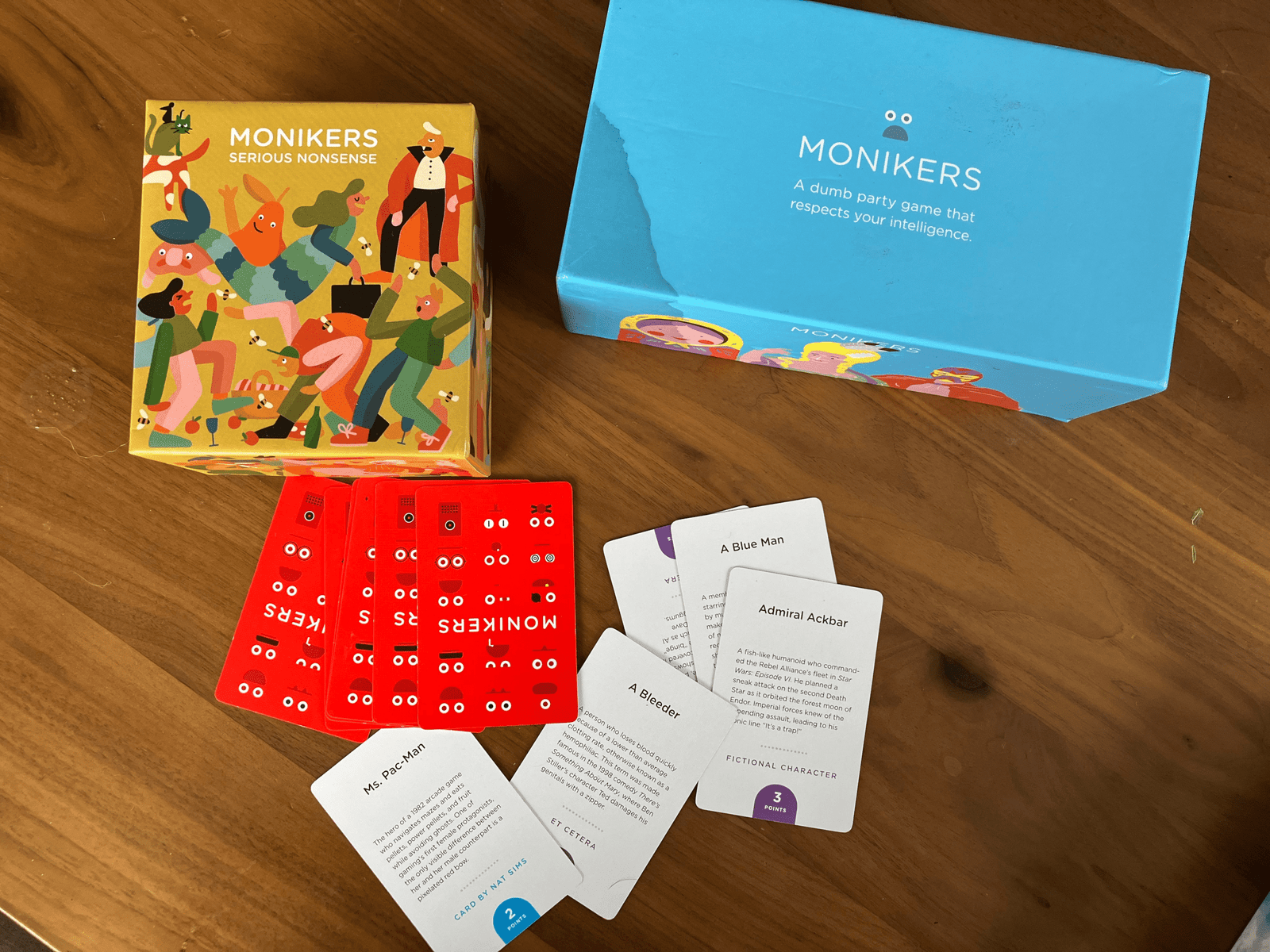
Players: 4 to 16+
Duration: 30 to 60 minutes
How to Play Monikers
Monikers is a raucous party game that combines elements of charades, Taboo, and even a bit of trivia, into a simple but wildly entertaining package. The game unfolds over three rounds, with the same set of unique and often bizarre words, a famous person or two, and silly phrases being guessed by the team in each round. The first person draws a card and works to get their team to guess as many clues as they can in a minute.
The first round allows players to use just words and sounds (but not the name itself) to prompt their teammates to guess the word or phrase. The second round limits players to using just a single word as a clue, ramping up the difficulty. The final round cranks the challenge even further by allowing only charades.
Why Monikers is a Great Party Game
The magic of Monikers lies in its escalating rounds of play, which take the initial understanding of the game’s set of words or phrases and twist it into increasingly hilarious attempts at communication. It’s a game that benefits from the shared memories and inside jokes that develop in real-time, making each play session unique and memorable. The transition from verbal clues to silent charades can transform even the most mundane phrase into a epic tale of miscommunication, laughter, and sudden realizations.
What sets Monikers apart from other party games is the depth of creativity and absurdity that it pulls from its players. By the time the third round arrives, players are often performing surprisingly complex charades, fueled by desperation and the shared history of the earlier rounds. This build-up of shared experiences throughout the game renders each round more engaging and enjoyable, fostering a spirited atmosphere of camaraderie and laughter.
Monikers also shines in its inclusivity, striking a fine balance between accessibility for new players and depth for seasoned gamers. The rules are simple enough for anyone to jump in and play without feeling overwhelmed, making it an excellent game for diverse groups, including those who may not typically enjoy party games. Despite the simplicity of the rules, the depth of strategy and creativity required to excel keeps the game interesting for all involved.
Conclusion: Elevate Your Gatherings
Party games are the secret ingredient for hosting successful gatherings. They engage, entertain, spark laughter, foster social interaction, and offer a dash of friendly competition. So gather your friends, set the stage for an unforgettable night, and let these games elevate your party to unparalleled heights of fun and excitement.
Can’t choose? Want a way to take all these party games with you in one box? Check out our review of the Gamegenic Lair 600+. It’s the game storage box with the mostest and will ensure that you always show up with the right game (because you brought them all.)
Want more party games? Check out our best games for large groups.
Frequently Asked Questions (FAQ)
How do I choose the right party game for my group or my family members?
When selecting a party game, consider the interests and preferences of your group. Look for games that match the energy level and complexity your friends enjoy. It’s also helpful to consider the number of players and the desired playtime.
Can party games be played virtually?
Yes, many party games can be adapted for virtual play. Some games are available in digital format or have rules that allow for play over video conferencing platforms. Be creative and adjust the rules as needed to follow suit with the digital format.
Are these games suitable for children?
While some party games are designed with a group of adults in mind, many are suitable for families and children. Always check the recommended age range on the game’s packaging for guidance.
Where can I find more information about a specific game?
For more detailed information about all the games, visit the publisher’s website or check out reviews from other players. Online board game forums and communities are also great resources for insights and recommendations.
How do I handle only one person being competitive in a casual setting?
Set the tone for the game night by emphasizing fun and camaraderie over competition. Choose games that focus on teamwork or have lighthearted themes to reduce the competitiveness. Remember, the goal is to enjoy each other’s company!
Can these party game ideas be adjusted for larger groups?
Some games come with variations or rules adjustments to accommodate larger groups. You can also make teams, play in teams or conduct tournament-style play to include everyone. Check the game’s manual for suggestions.









Pingback: From Go Fish to Go Fun: 6 Insider Tricks for Bringing Card Games to Family Time - Gameindustry.com